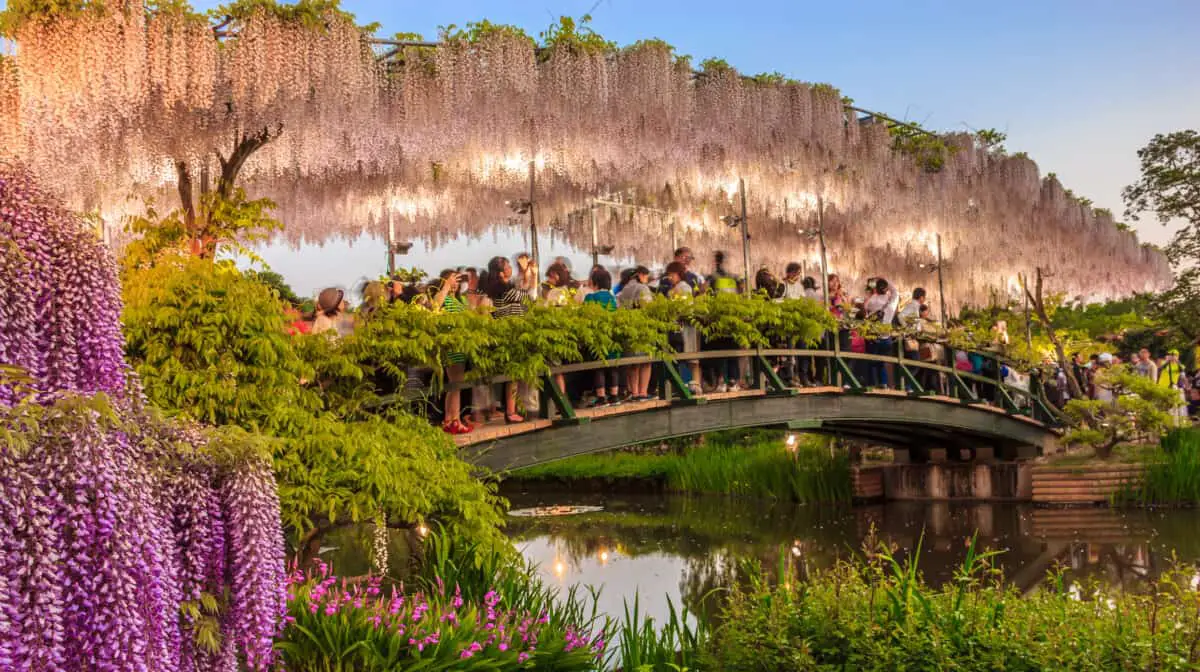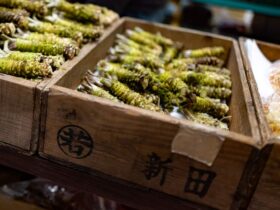The top 10 wisteria arbors and tunnels in Japan have been listed below:
- Tokyo’s Kameido-Tenjin Shrine
- Tochigi’s Ashikaga Flower Park
- Wakayama’s Miyama-no-sato
- Aichi’s Mandara-Ji Temple
- Kyoto’s Byodoin Temple
- Hyogo’s Shirai Omachi Fuji Koen Park
- Kanagawa’s Yokosuka Shobu-en
- Aichi’s Tenno-Gawa Park
- Nara’s Kasuga Taisha Shrine
- Hyogo’s Byakugo-Ji Temple
Continue reading to discover why these 10 Amazing wisteria arbors and tunnels are classified as the most breathtaking in Japan and why you should consider visiting them on your exploration of Japan.
Tokyo’s Kameido-Tenjin Shrine
The deity of scholarship, Kameido Tenjin Shrine, attracts students of all ages who pray to higher forces to help them pass their examinations. It’s no wonder that this temple was recognized as one of Edo’s 100 Famous Views, with purple wisteria in spring and pink plum trees in late winter or early spring.
The exquisite grounds of Kameido Tenjin dubbed the “flower shrine,” have made this location a favorite of Japanese painters.
Kameido Tenjin Shrine Official Website
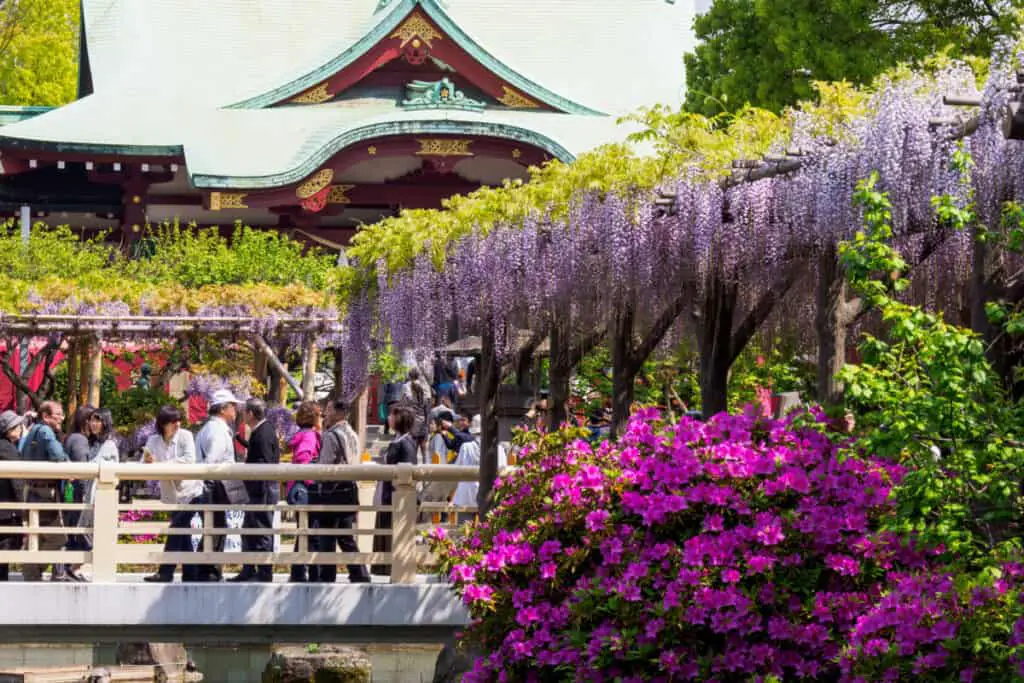
When Should Tourists Visit the Kameido Tenjin Shrine to Experience Wisteria Flowers in Full Bloom?
From February until mid-March, the plum festival takes over the grounds. Aside from seeing the pink and white blooms, tasty food, and musical acts around the temple.
During the shrine’s Wisteria Festival, which runs from late April to early May, tourists rush to witness trellises of violet wisteria blooms blooming around the turtle-filled pond.
Tochigi’s Ashikaga Flower Park
In Ashikaga City, Tochigi, the Ashikaga Flower Park is one of the greatest sites to see wisteria flowers in full bloom. There is a lot of blue, white, and pink fuji at Ashikaga Flower Park, as well as a yellow laburnum that appears like yellow fuji.
One hundred-year-old fuji tree’s branches are supported to form a gigantic umbrella of blue blossoms.
A lengthy tunnel of white fuji blossoms also exists, while a yellow kingusari tunnel will need a few more years to mature. Yae-fuji, a cultivar with more petals than the average, is also displayed.
Ashikaga Flower Park Official Website
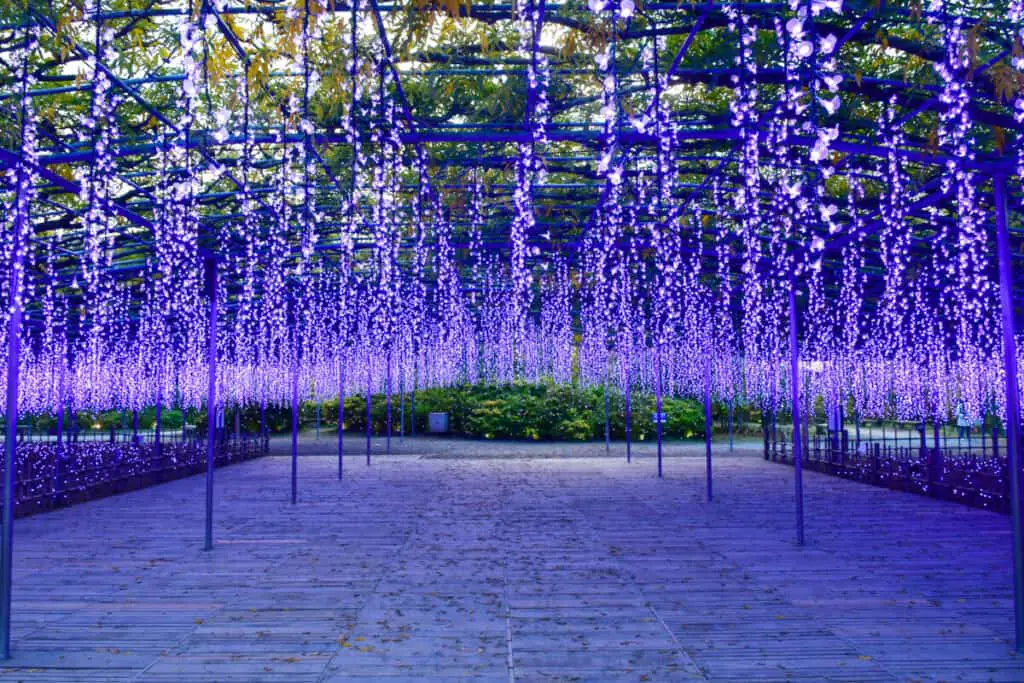
When Should Tourists Visit the Ashikaga Flower Park to Experience Wisteria Flowers in Full Bloom?
The Ashikaga Flower Park has also gained a reputation for putting on a large-scale winter illumination show in recent years. Ashikaga Flower Park opens its gates every evening from late October to early February to allow visitors to meander around the intricate lighted show, which draws ever-increasing crowds.
Wakayama’s Miyama-No-Sato
In Miyama no Sato Forest Park, there is a 5400 foot-long wisteria trellis walk named as Japan’s longest wisteria trail.
Every year from late April to early May, the Wisteria Festival takes place in Wakayama’s Miyama-No-Sato. Many people come from all across Kansai to see this breathtaking scenery.
The stunning view of the wisteria path and the Tsubayama Dam may be seen if you walk 314 feet to the observatory tower.
There is another, less steep approach to the top of the trail for those less eager to climb high stairs to access the observatory rapidly. You may stroll up to the tower on this pathway while observing the lovely wisteria vine that borders the walkway.
Miyama No Sato Forest Park Official Website
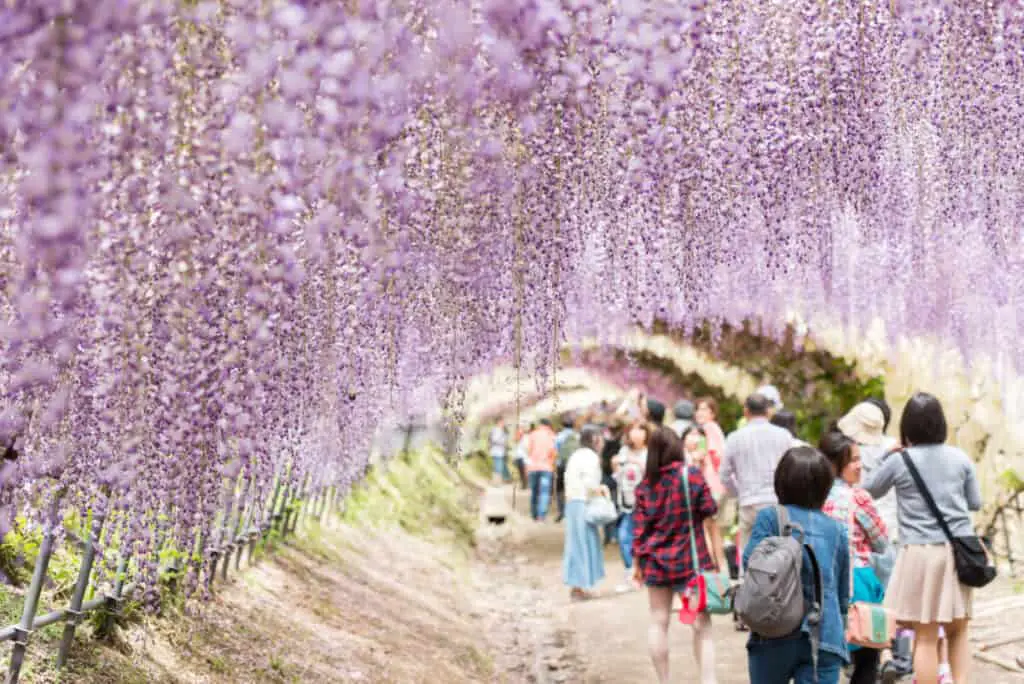
Aichi’s Mandara-Ji Temple
Mandara-ji Park in Konan City, Aichi, is one of the most outstanding places in Japan to experience a Wisteria Festival.
An average temple in Nagoya’s northwestern district transforms into a gorgeous location with roughly 60 wisterias of 12 species between late April and early May.
Beautiful flowers, well-kept booths, and other flowers such as azalea and peony draw tourists from far away.
Mandara Ji Temple Official Website
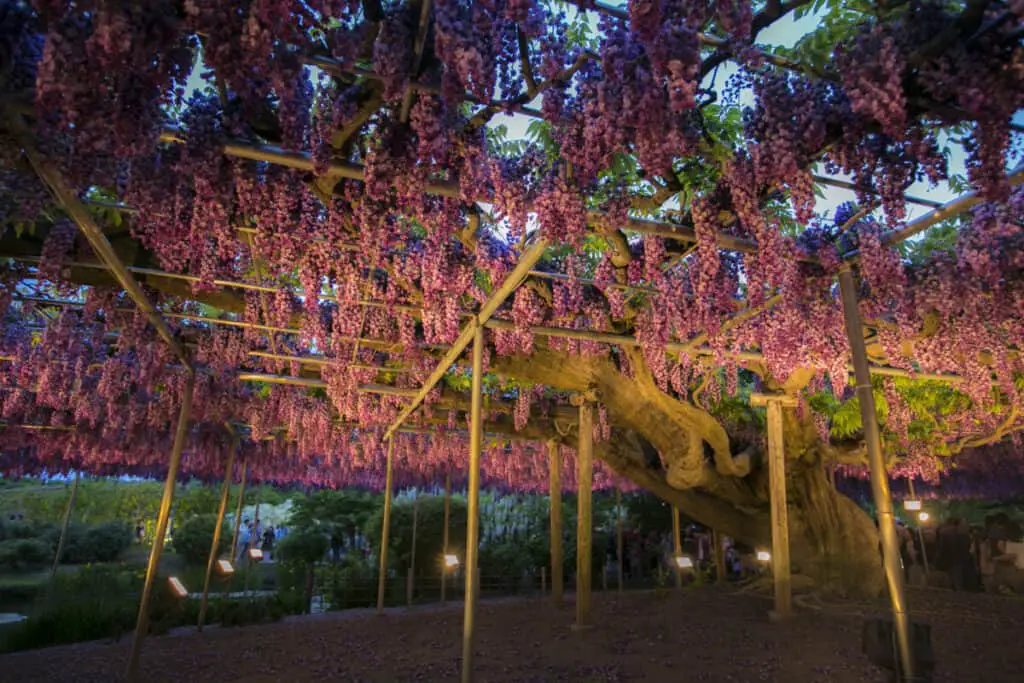
A 30-minute journey on the Meitetsu Inuyama Line or a city bus ride from Nagoya will get you to this park. Take a city bus to the Mandara-ji bus stop from Konan Station.
The Park is free to the public and is open 24 hours a day. Don’t miss the wisteria park’s lighting event from 6:30 pm to 9:00 pm to experience the lovely ambiance.
Kyoto’s Byodoin Temple
The most famous wisteria site in Kyoto is Byodoin Temple in Uji. Byodoin Temple is a Buddhist Pure Land environment with wisteria trellises to appreciate while observing the magnificent temple in the background.
The exquisite temple, built as a retreat for prominent politician Michinaga Fujiwara, is notable for its gorgeous garden and symmetrical main hall.
The nearly 250-year-old wisteria in the yard is still healing from recent trimming, but its long strings of blossoms still appear every spring.
Wisterias can also be seen in abundance in the surrounding region. JR or Keihan Uji stations are around a 15-minute walk away from Byodoin Temple.
Byodoin Temple Official Website
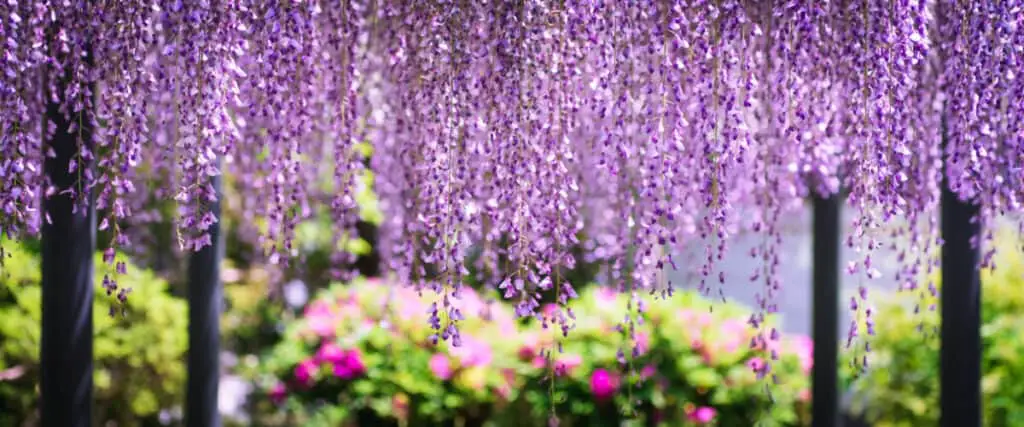
Hyogo’s Shirai Omachi Fuji Koen Park
In Hyogo’s Shirai Omachi Fuji Koen Park, the lovely hanging wisteria flowers are best seen in May. You can enjoy the Japanese countryside with a watermill, pond, and mountains in the background. In addition, there is a 69,000 square foot daffodil field that blooms in April.
This Park, which is located on the border between Hyogo and Kyoto, is open primarily to enjoy wisteria in blossom.
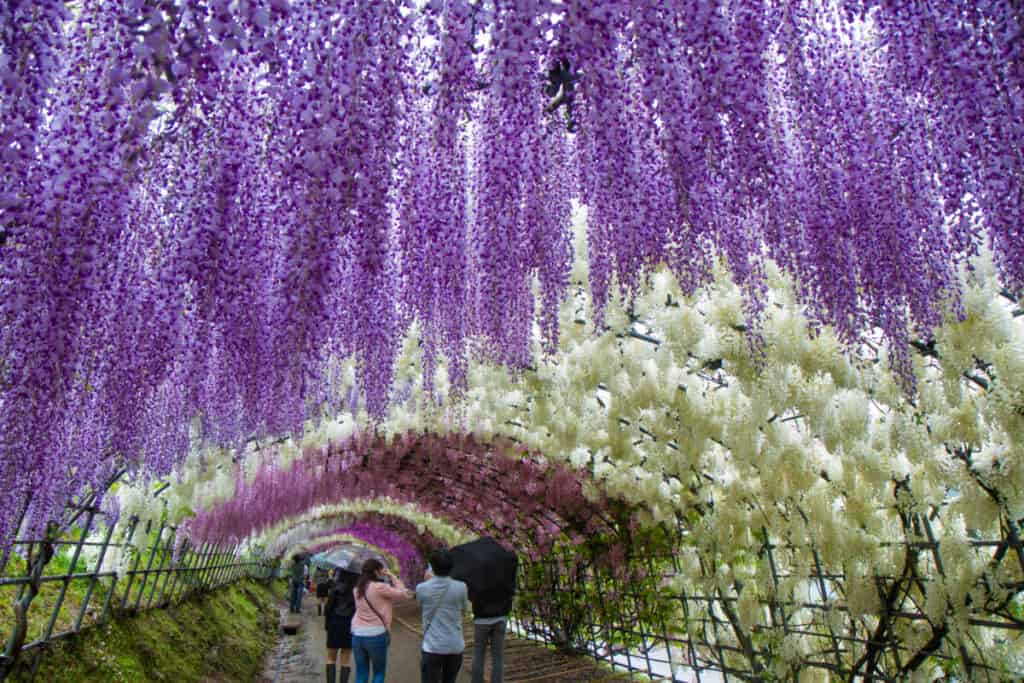
The 75,000 square foot area features a total of 1640 foot of wisteria trellis, which are illuminated during the wisteria festival in May. The opening stage transforms into a flowering show. A cab ride from JR Wadayama station is 3.7 miles.
There is plenty of parking. However, it can get congested during the high tourist seasons and holidays.
Hyogo Shirai Omachi Fuji Koen Park Official Website
Kanagawa’s Yokosuka Shobu-en
By mid-April, Japan’s annual pink sakura bloom has faded, and Yokosuka Shobu-en in Kanagawa is welcoming a new wave of flower species, the purple hanging wisteria that creates a lovely panorama.
Yokosuka Shobu-en’s wisteria has grown into magnificently long strings of blooms in a variety of hues that wow visitors with their enigmatic beauty and aroma. Their colorful blooms are a feast for the eyes and soul, especially when arranged in bundles or groups to make tunnels.
Many types of flowers bloom in each season at Yokosuka Shobu-en Park, and there is even a calendar of which flowers bloom in which month throughout the year.
Yokosuka Shobu en Official Website
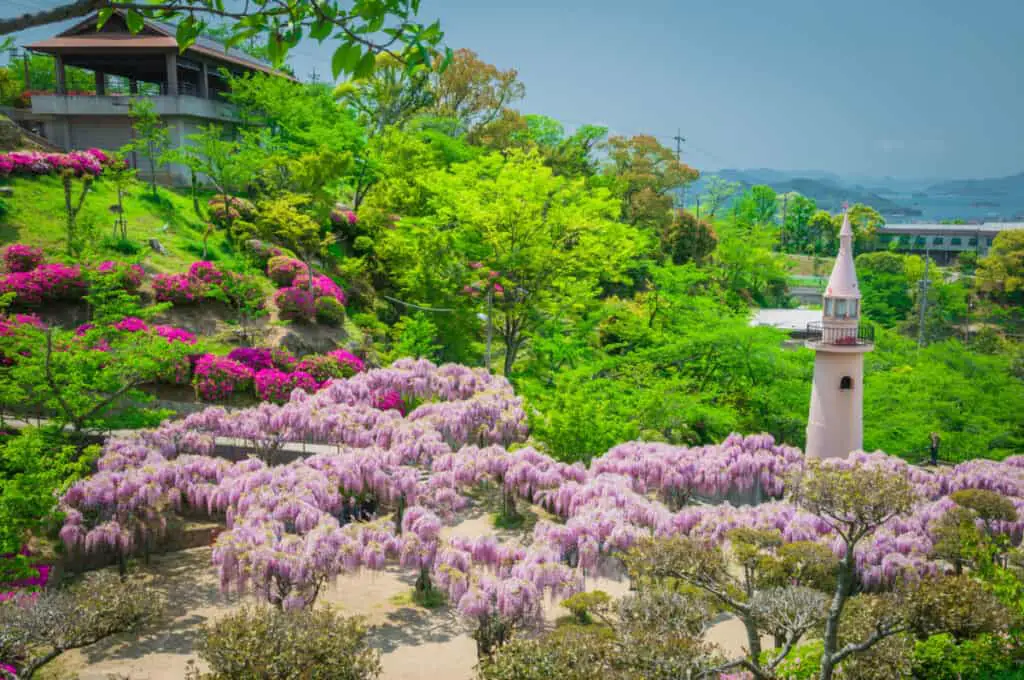
The wisteria transforms the area into a lovely environment filled with vibrant purple, pink, and delicate white blooms that delicately dance in the breeze.
Take a walk in the garden and enjoy the relaxing ambiance that transports visitors away from the metropolis. It offers a spectacular vista of many rows of Wisterias.
It is recommended that you take a pause and enjoy the view beneath the bamboo trellis of wisteria vines.
Aichi’s Tenno-Gawa Park
Tennogawa Park is built around Maruike, an elliptical pond that is also a relic of the Tenno River that initially flowed through Tsushima City and is surrounded by lush avenues of trees.
Until the Edo era, the Tenno River ran through the heart of town, but due to the accumulation of clay and sand, it formed a cove and subsequently Maruike.
The seasonal changes that color Tennogawa Park’s water park are charming, and the cherry blossoms that bloom across the park in the spring are a highlight.
Tenno Gawa Park Official Website
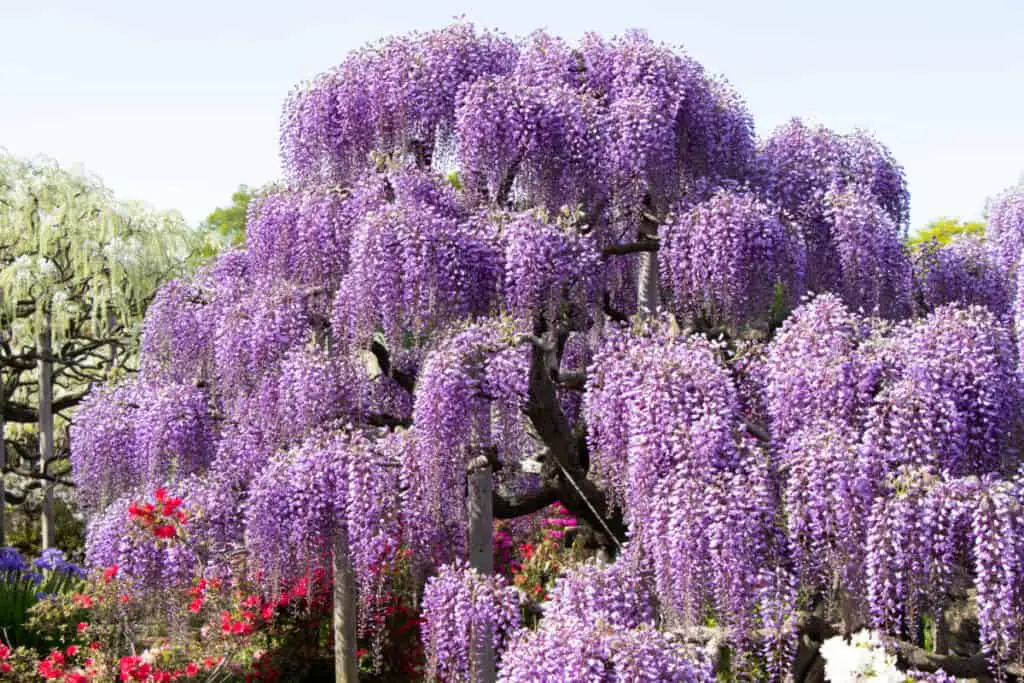
When Should Tourists Visit the Tenno-Gawa Park to Experience Wisteria Flowers in Full Bloom?
At Tenno-Gawa Park, the baton evolves to wisteria around Golden Week, and the Owari Tsushima Wisteria Festival is celebrated. Water lilies bloom in the region around the bridge in Nakanoshima beginning in early summer, delighting tourists with their lovely white petals.
Nara’s Kasuga Taisha Shrine
Every spring, more than 200 wisteria trees blossom at the Kasuga Taisha Shrine in Nara in early May. The wisteria blossom is the shrine’s emblem, and the mikanko, or shrine maidens, wear headpieces with exquisite purple flowers.
Wisteria is the Fujiwara clan’s enshrined monogram, which may be seen throughout the temple.
Sunazuri-no-Fuji, with its long strings near the main structure, is recognized for its elegance among the many wisteria vines located inside the precinct.
Kasuga Taisha Shrine Official Website
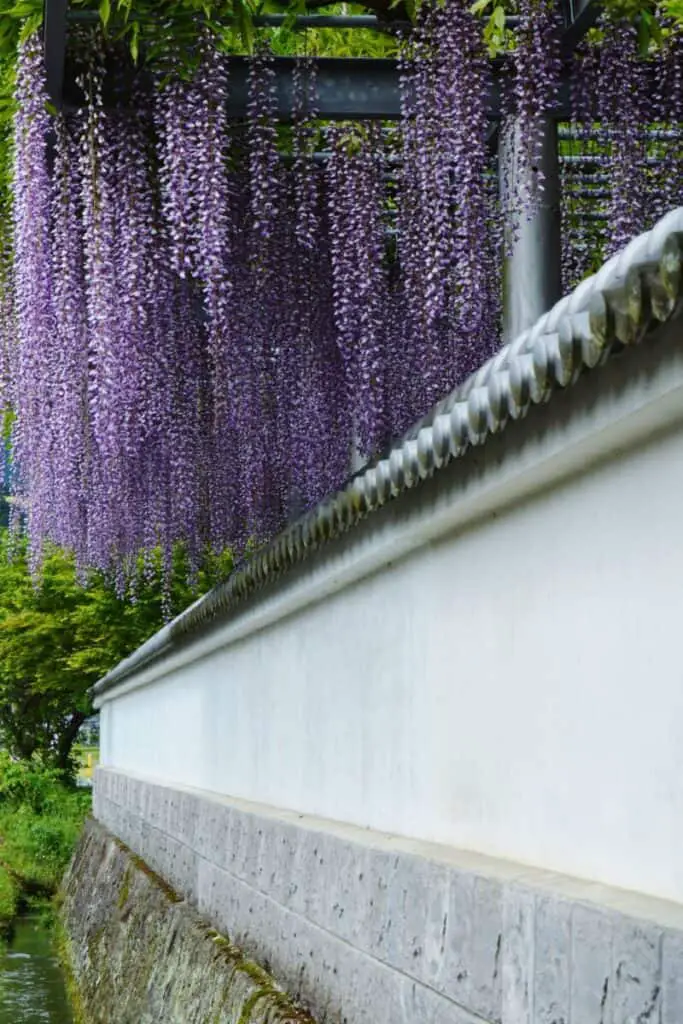
How to Get to The Kasuga Taisha Shrine
Kasuga Taisha Shrine may be reached by foot or by bus. Take a bus going towards Kasuga Taisha Honden from either JR Nara Station on the Yamatoji Line or Kintetsu Nara Station on the Nara Line.
Take the Kasuga Taisha Honden bus to Kasuga Taisha Honden. It takes roughly 10-15 minutes to get there.
Hyogo’s Byakugo-Ji Temple
Byakugou-ji is an ancient Buddhist temple in Tamba City, Hyogo Prefecture, that was built in 705. Here, the wisteria blooms in long clusters that almost touch the ground.
The lovely hanging flowers may be seen around the temple grounds.
Byakugo Ji Temple Official Website
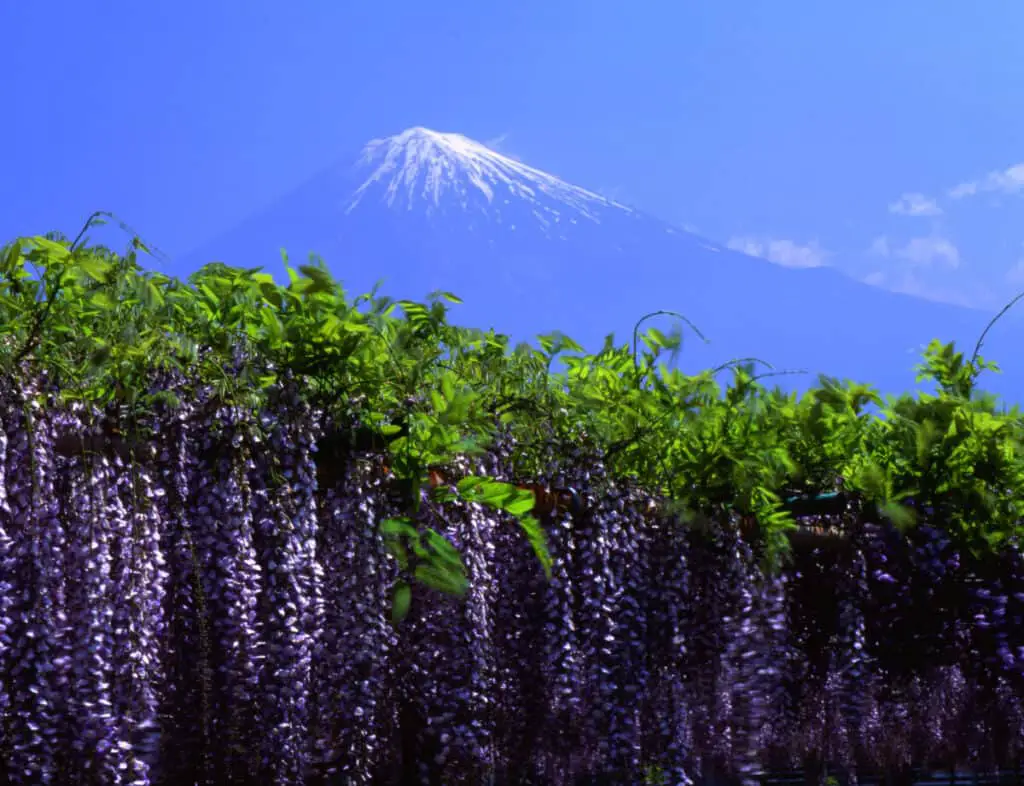
Every year in mid-May, a unique wisteria festival is held here, featuring local handicrafts and even mochi-pounding. Late April to mid-May is the best time to visit Byakugo-Ji Temple.

